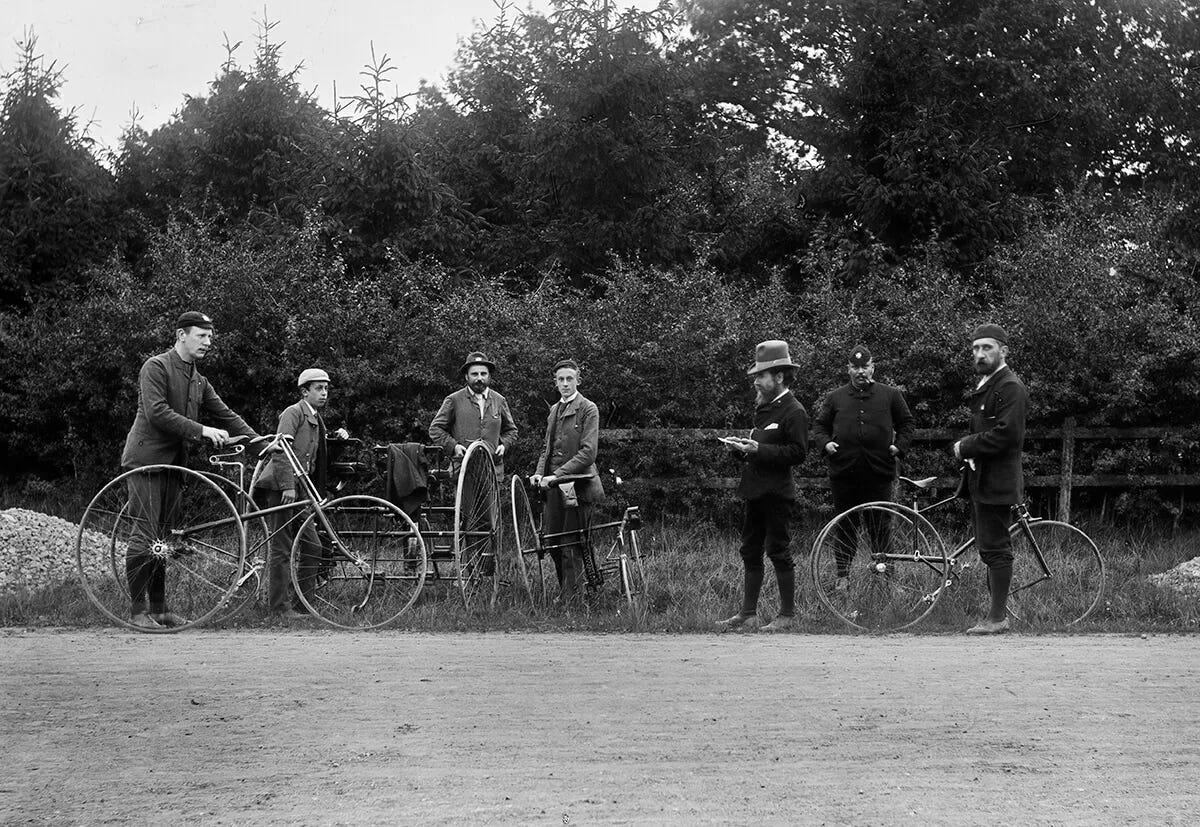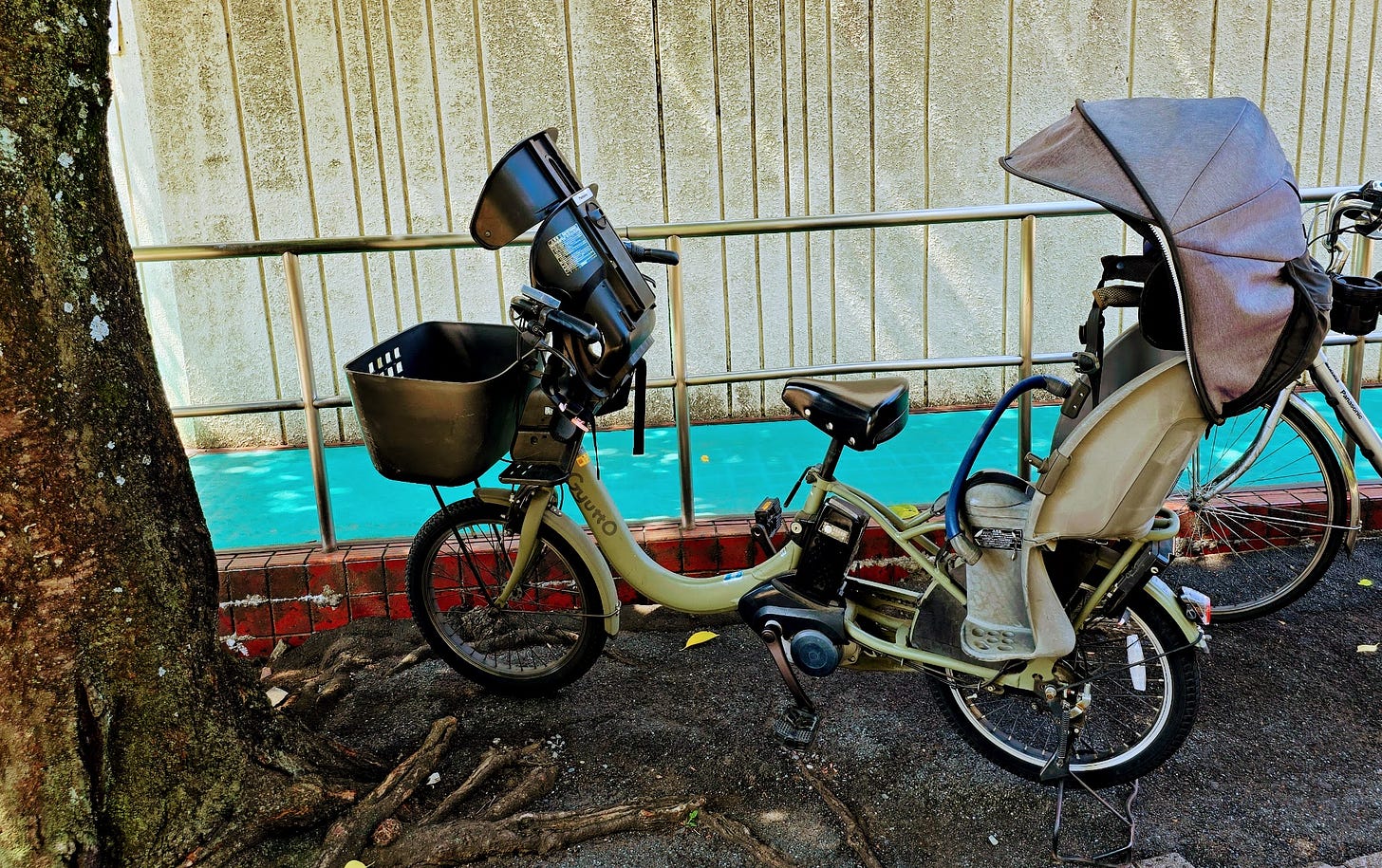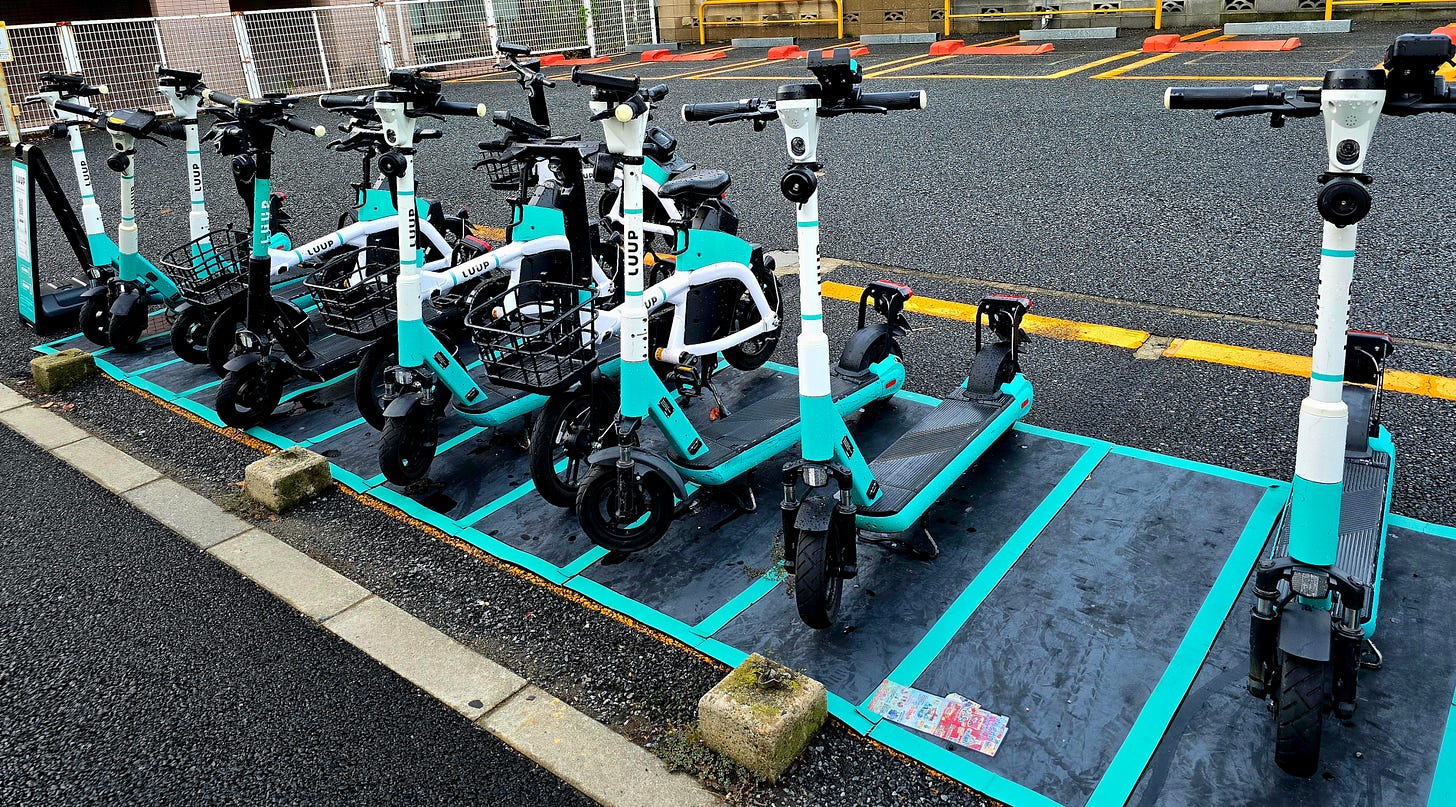
My Wheel is in the dark!
I cannot see a spoke
Yet know its dripping feet
Go round and round.
Emily Dickinson, 1859
The year is 1902. The young writer who would become one of his country's most celebrated authors is brooding in his rented room thousands of miles from home when a message arrives. The bearer of the message is the writer’s landlady. The young writer receives the message as “the first clause of a capitulation treaty”.
Its content, which is given as heartfelt advice, is that it’s time for the writer to learn to ride a bicycle.
I’ve written before about the Japanese novelist Natsume Soseki and mentioned his unhappy time in England on a scholarship.
One of the accounts he has left of his time in London is his Bicycle Diaries. Here he tells, in a knockabout, partly self-deprecating, partly self-pitying way, of his adventures while learning to ride a bicycle in Clapham, the part of London he was living in at the time.
His account begins, not without a trace of what we’d call body shaming today in its “humorous” tone, of Priscilla, his landlady, laboriously climbing the stairs: “To climb the 42 steps took her three minutes and five seconds, with two breaks in the middle.” 1
He got on well with Priscilla, though, and seemed fond of her. She, for her part, was worried about him spending too much time in his room. Her suggestion was a variation on the old idea that ‘you should get out more’. And Soseki, hardly thriving as he brooded in his room and seemingly keen to please Priscilla, took her advice.
Soseki duly visited a bicycle instructor based in a workshop on nearby Lavender Hill. His first mishap occurred when, probably because he confessed to being a complete novice, he was offered a lady’s bicycle. He took offence at this perceived affront and demanded to be given a standard bicycle instead.
What he was offered instead was what we would have called in my youth a “boneshaker”, an ancient and rusty contraption that would barely move. “So, I grabbed the thing two-handed and attempted to push it, but it only made a rusty squeak and refused to budge.”
With the help of the instructor, Soseki managed to balance on the bike momentarily before the seemingly inevitable mishap:
“The instructor pushed the frightened student partly for fun. All the instructions and help were nothing but a preparation for the inevitable: a dive into the sandy ground the moment he let go of the bicycle. This was such a cruel trick that only God could have invented it.”
By 1902, cycling in England had long since passed from novelty to everyday occurrence. The highly efficient bicycle had been around in some form for more than one hundred years, though perhaps the first true bicycle emerged in Germany in 1817. By the 1870s, mass production of bicycles that would look familiar to us today was common.
Cycling had also emerged as a popular sport. And in a city like London, it would have represented a great way of getting about, especially before the invention of its arch enemy, the motor car. Cycling became part of the fabric of life, a wonderful way to enjoy the parks of the city – when weather permitted – and to get fresh air and exercise. Soseki’s landlady had given good advice.
Reading Soseki’s adventures took me back to my own experience as a first-time cyclist on the family farm in Devon. There was a lane from the public road, maybe about half a mile long, with a significant incline just before it reached the main farmyard. The latter had been recently paved with concrete with the help of my grandfather, a retired roofer and bricklayer, and tarmacadam had just been laid down on the lane itself, providing ideal conditions for practice.
My purple-framed bicycle, inherited from an elder brother, was a pretty basic contraption but perfectly roadworthy. Crucially, the brakes worked. At the age of 7 (I came relatively late to cycling), I was soon able to balance the bike and steer down the slope, aiming at the hay barn in case I needed a soft landing due to brake failure. At each attempt, I’d start from further up the short hill and increase the velocity (a word I’d just learnt) with which I’d burst into the farmyard.
Around this time, one of my older brothers fell while running down this lane and gashed open his knee. It was a scary-looking wound, which required a trip to the hospital. He recovered quickly, but the incident put me off my nascent desire for speed.
I switched to trying to pedal along a flat part of the lane, focusing on balance and the awkward pedalling movement while keeping alert for a possible delivery lorry or the vet’s car, which would occasionally appear unannounced in an arcing cloud of dust or spray of slurry. It took time, but I was proud of myself for learning to ride a bike without a single serious fall and was soon able to explore the narrow country roads that connected us with the outside world.
Soseki had no such luck. His tale is one of repeated falls and constant social anxiety about how ridiculous this might make him appear to onlookers (something I was spared on the farm, where cows gazed past me as if I was air).
At one point, Soseki recounts how he met with the “unexpected obstacle” of a large group of schoolgirls in the road. He was just counting himself fortunate to have avoided hitting any of them when he realised he was still speeding down a slope towards a junction.
He records his alarm on finding that the bicycle showed “no sign of stopping”. “As if hell-bent on effecting a murder-suicide, the bicycle sped toward the sidewalk at a terrifying speed. It went up onto it and kept going until it slammed into a wooden fence and then ricocheted a dozen feet back.”
This episode didn’t cause him (or the bicycle) too much harm, but it ended with a laconic and discouraging exchange with a policeman he’d already encountered, a figure who seemed to pop up like officer Dibble in the 1960s cartoon Top Cat every time Soseki came to grief on his out-of-control bicycle.
These days, the role of the pedestrian in my part of Tokyo is more fraught than that of the cyclist. At any time of the day, my quiet enjoyment of the pavement is threatened by the rapid insurgence of speeding bicycles. Although technically not allowed to use the pavement (sidewalk), most cyclists here do, and this behaviour seems broadly tolerated – until an accident occurs.
Perhaps the most dangerous bicycles are the heavy, electric-assisted ママチャリ, or mama-charis, which are mostly used to ferry small children to and from school or to after-school activities. It is a healthy and convenient mode of transport for them but somewhat hazardous for the hapless pedestrian, as these heavy contraptions, often weighed down by the rider and one child at either extremity, hurtle along without deviation, expecting everyone in their path to step – or leap – for safety. 2 Bells are seldom used to alert the unsuspecting walker. I find myself constantly looking around me as I walk, like a lone soldier timidly entering enemy territory.
The deadliest of the mama-chari riders are men. For some reason, many of them sport camouflage paint, and they are certainly ridden like weapons of war. So, dear reader, if a sudden and unexplained gap in publication of the English Republic of Letters ever occurs, it will probably be because your author has been tossed into the nearest allotment by one of these rampaging machines, camouflaged against the background of the neighbouring cabbage patch and invisible to me until it was too late to leap to safety.
Opposite my flat in Tokyo is an e-scooter and bicycle “station” for one of the most popular short-term hiring systems in the city. Out of caution, and perhaps the risk of ridicule like that which Soseki was subject to, I’d always avoided such schemes in the past. I’m not surprised to learn either that the use of e-scooters is highly restricted, at least in theory, in London.
I’m generally quite happy to walk around the city and use public transport. Tokyo is a convenient city in that respect.
But one Sunday not long ago, following a whim whose origins I still don’t understand, I decided I’d try out an e-scooter.
At least I didn’t have to negotiate with an obdurate bicycle shop owner, as Soseki did; my first hurdle was to get the app to work.
While Soseki grappled with a language not his own, I had to adapt myself to the logic and UI of an app designed for an audience of digital natives.
Eventually, I was able to push all the buttons in the right order, load up my ID and set up the payment system. I was ready to tackle the e-scooter itself. I made my way to the “station”, which is to one side of a car park.
Having disengaged my chosen temporary steed from its stand and activated it through a few simple steps, I was able to give it a try. My first impression was that it was heavier than expected. My second was that it was less stable than I had thought. Hardly promising. Time for second thoughts?
However, the car park was empty, and I was able to take a few trial trips around it to get my balance. I became slightly more confident and set off on some very quiet back streets towards a local park.
I progressed in spurts of acceleration punctuated by nervous braking and rapid deceleration. It was by no means as easy as I’d hoped. But after a few minutes, I felt I was gradually getting the hang of it.
Then I found myself approaching a narrow alleyway that led to the local botanical garden.
I’d walked there many times. On one side is a rough breeze-block wall; on the other, a short row of houses. The first house in this row is home to a sleek black dog that I often see chained up outside – the only guard dog I have seen anywhere in the neighbourhood. It had sometimes barked at me, sometimes not, but as a pedestrian, I’d got used to the dog’s mercurial ways and its occasional loud disapproval of my passage.
However, the sight of me on an e-scooter was something new and irresistibly exciting (or threatening?) for the dog. It immediately launched into a barrage of furious barks while straining to its uppermost reach on the chain. I prepared for an attack which I knew could not come – its chain is a short one.
Perhaps flashing across part of my mind was the distant memory of one of my brothers who used to travel to meet the school bus on his coveted red bicycle. It was a fine vehicle and altogether too attractive to the dog who lived on a neighbouring farm.
Both the dog and the farm belonged to two women we only knew of as the Stone Sisters (as if they were some kind of Motown act). They farmed a rather rough patch of land a mile or two from our place. And their unleashed dog, part collie, part Hound of the Baskervilles, used to bark from inside the farmyard gate at my brother. It obviously coveted that red bicycle and its rider.
One day, as he passed on the way to school in the cool morning drizzle of a Devon autumn, my brother saw the gate was open. He knew the implications of this and began to pedal as fast as he could to get clear of the impending danger.
But the dog was poised like a well-directed arrow and was not to be denied its prize. It shot out of the open gateway and sprinted after my frantically pedalling brother, reaching him in no time to nimbly inflict a neat bite on his calf with its gleaming fangs.
I think my father had words with the sisters after that, and the gate was never left open again.
Anyway, all of this ancestral woe may or may not have been in my mind, but as I passed through the narrow strait, dog on one side, rough wall on the other, on my wobbly e-scooter, I made the fatal mistake of flinching.
The scooter immediately trembled and lurched towards the wall as I forgot to take my hand off the accelerator. My shoulder hit the wall, and I clattered to the ground with the scooter beneath me. The dog by this time had stopped barking and retired, vindicated and victorious, to its quarters.
I won’t say I lay bleeding and helpless on the road, but as I got up and dragged the heavy scooter into a vertical position, I realised that I had cuts and grazes on my shoulder, arms, hands and leg.
Soseki agonised over the way his mishaps would be seen by others. In a long passage, he describes his socially inept attempts to get out of a proposed cycling trip to Wimbledon with a young lady of his acquaintance by feigning concern, rather absurdly, over the weather. Scared of looking like a fool in front of her on a bicycle, he made an idiot of himself in her living room instead.
My only witness, however, was the dog. Though I’m not sure I can ever look it in the eye again.
Soseki’s attempts to learn to ride a bicycle ended in failure. “I had five major falls and numerous small tip-overs. One time, I crashed into a stone wall and scraped my shin, and another time, I hit a standing tree and lost a fingernail. There was nothing but struggles, troubles, and injuries.”
After many attempts, he gave up trying in the end, but at least he could say he gave it his best effort.
I still have the scars from my own attempt to master the e-scooter, one of which may stay with me for a while. If this had happened a few years ago, my pride would have impelled me to try again to master the wretched machine, even if only to abandon it immediately after achieving that minor victory. But I realised that my body doesn’t heal as quickly as it used to. So, unlike Soseki, I immediately gave in and decided to stick to walking or public transport.
Soseki summed up his experience of following his landlady’s advice to learn to ride a bike in this way: “I had wasted a lot of the precious time allotted to my overseas studies and had doubled my food bill because of all the exercise I got.” He dismissed the whole experience as an “unmitigated disaster”.
I’m choosing, instead, to categorise my own short-lived debacle with the e-scooter as a timely and even welcome reminder of the folly of following our whims.
All the Soseki quotations are taken from Bicycle Diaries (I Am Soseki: Short Stories by Nastume Soseki), translated by Tom Pinch. Published by Mondrala Press (2022)
English Republic of Letters is a reader-supported publication. To become a free subscriber, use the button below. To become a paid subscriber at a 50% discount (under $14 a year) and gain access to the Supporter Sidebar, click here.
I understand that if the riders have their children on board, they will opt for the safer route of the pavement. I’d do the same. But I wish they would show a little more caution in relation to pedestrians.












What a delight to read, Jeffrey, as I recalled my own bike-riding. I enjoyed how you interwove your experiences with those of Soseki. Poor man. I wonder what it was that made bike riding so difficult for him.
I was perhaps a year or two younger than you when I learned to ride a bike. The problem, as I see it now, was that the bike was much too big for me and its gears a mystery; nonetheless, I determined to ride it as it was the one functional bike we had. We had only roads to ride on then, on either side of which was lots of bluestone, which cars scattered. Believe me, hitting that bluestone is no fun; it leaves scars. Both of my knees have them. Learning how to drive a car seemed easier (and for that I was required, first time out, on the Capital Beltway!).
E-scooters I will never try. They became quite a fad in the D.C. area, and because of the recklessness with which they were used - all over the lane, going downhill with no hands (we have some very big hills in Arlington), with two people aboard, abandoning them everywhere - the regional governments each started enacting regulations for their use. One company was made to leave the area and take all its scooters with it. Driving behind one was to court an accident. I'm sorry to learn you wiped out but at least it wasn't in traffic.
Enjoyed this, Jeffrey. Thank goodness bikes have come on a bit since the bone shaker!
Your tumble sounds rather like my son’s one and only encounter with an e-scooter. I wasn’t there to see it - it was while he was at university - but it put him off for good. (He rode a bike aged five, so I don’t know why scooters are so tricky!)
I was put off mopeds for life after coming off one on a dirt track at the top of a mountain in Greece. Sometimes the machine isn’t meant for us!